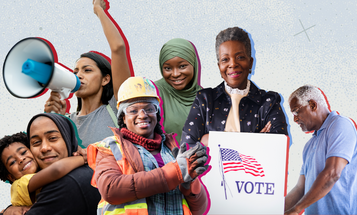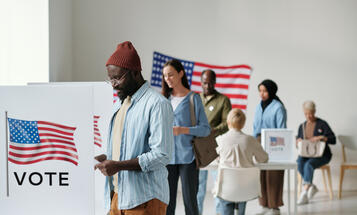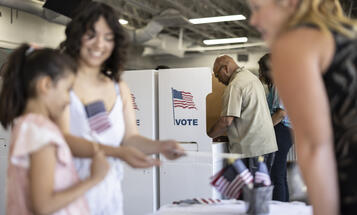
Voting in the 2014 Midterm Elections
Early voting and Election Day Registration may have boosted turnout
For those of us who care deeply about voter participation and voting rights, 2014 was, in many respects, a dispiriting year. However, by one metric we can take heart: the role that early voting and Election Day Registration may have played this year in possibly boosting turnout in ways that may present a turning point for advocates of legal and structural election reform.
The trouble, as it often does, took place before Election Day. Voter identification laws were in place in a slew of new states, and most damagingly upheld in Texas where a federal judge had found over 600,000 voters were without the ID needed and that the law was purposefully discriminatory against African Americans and Latinos.
And indeed there were numerous reports of American citizens being denied the right to vote on Election Day because of that state’s law, as well as reports of misapplication of voter identification rules elsewhere. The monster vote suppression law in North Carolina that eliminated Same-Day Registration and cut back on early voting, among other provisions went ahead. There were the all too typical incidents of voters being denied the language assistance they are legally required to get. And worst of all, this was the first election without the protections of Section 5 of the Voting Rights Act, which would have done much to prevent the acts of voter suppression that were put into law in several parts of the country, including Texas.
There were plenty of problems on Election Day too, with the Election Protection coalition reporting record numbers of calls of questions and complaints.
At the same time there were silver linings. First, though the loss of Same Day Registration in North Carolina was devastating, the news was far different in other states. Most importantly, voting rights advocates and concerned citizens handily beat back a cynical attempt to take away Same Day Registration, the reform firmly proven to increase turnout, in Montana. Moreover, turnout in Connecticut was far higher than expected, which election officials attributed to this being the first year that state allowed for Election Day registration. Wisconsin, a state that has Election Day registration, beat its own outstanding record and had its highest turnout in a midterm election ever this year. It was the same story in New Hampshire: the Secretary of State told the Associated Press the state could see “the highest number of voters in a midterm election.”
Second, after a decade of largely unnoticed academic research demonstrating the necessity for campaigns and advocacy organizations to proactively promote and utilize election reforms in order for them to be effective, this year people noticed. In what would seem anecdotally to be in an unprecedented fashion, building upon the success of the Obama campaign in the last two presidential cycles, both parties, candidates, advocacy organizations, community groups, and churches understood the need to undertake intense mobilization efforts to make early voting a reform that would actually bring new voters into the process, rather than just something that makes it easier for people who would have voted anyway.
There is a great deal of evidence at this early stage to show this was the case and that the effort was fruitful. According to an October 31 New York Times report, “More than 20 percent of the nearly three million votes already tabulated in Georgia, North Carolina, Colorado and Iowa have come from people who did not vote in the last midterm election... [In Georgia and North Carolina] black voters… represent 30 percent of the voters who did not participate in 2010. By comparison, 24 percent of all those who voted in those states in 2010 were black.” In Florida, “A get-out-the-vote drive that encouraged minority voters to cast their ballots Sunday saw record-breaking turnout Palm Beach, Broward and Miami-Dade counties… Overall, the numbers show a 48.7 percent increase over 2010…” According to MIT Professor Charles Stewart, among early voters in Florida, 15.4% did not vote in 2010. Among African Americans, 19.3% of early voters had not voted four years ago and among Hispanics, 24.7% had not. In Colorado, voters who didn’t participate in 2010 reached 33 percent of early voters as of the Saturday before Election Day.
Moreover, despite prognostications of doom, young people actually appear to have comprised a slightly higher share of the electorate this year than they did in 2010. And the Latino share of the vote appears to have stayed stable.
Overall turnout numbers are not yet available. Vote suppression laws dominate the landscape for the moment, and there are major concerns about ongoing cynicism and alienation from the election system that emerged this year. At the same time, if this is the year that concerned groups and individuals got wise to how to fulfill the potential of election reforms that are meant to increase participation, something will have been gained.


